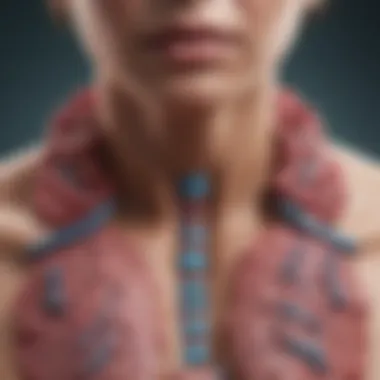Understanding Thyroid Cancer and Lymph Node Involvement


Intro
Thyroid cancer has gained increasing attention in recent years due to its rising incidence and complex nature. Understanding the dynamics of thyroid cancer in relation to lymph nodes is crucial, as lymphatic involvement alters patient prognosis and treatment strategies. Lymph nodes act as filters for malignant cells, and their involvement signifies a potential for metastasis. This section lays the groundwork for an in-depth exploration of the topic.
Key Findings
Thyroid cancer's ability to metastasize to lymph nodes necessitates a thorough understanding of its pathological behavior. Here are some key findings:
- Metastasis to lymph nodes can occur in differentiated thyroid cancers like papillary and follicular thyroid carcinoma.
- The extent of lymph node involvement often correlates with the stage of cancer, influencing survival rates and treatment modalities.
- Advanced imaging techniques, including ultrasound and PET scans, have enhanced the detection of lymph node metastasis early in its course.
- Recent research suggests a focus on molecular profiling can identify patients at higher risk for lymphatic spread, enabling tailored management.
The significance of these findings within the scientific community cannot be overstated. As more cancers are detected at early stages, understanding the role of lymphatic spread aids in refining treatment algorithms and improving patient outcomes.
Implications of the Research
The insights gleaned from investigating thyroid cancer's lymphatic involvement have substantial real-world implications.
- Knowledge of specific risk factors for lymph node metastasis allows for individualized patient management strategies.
- Accurate staging and assessment techniques can lead to appropriate surgical decisions, particularly regarding the extent of lymph node dissection necessary during thyroid surgery.
- By integrating findings into clinical practice, healthcare providers can improve the monitoring and follow-up protocols for at-risk patients.
Looking ahead, the exploration of new treatment regimens and targeted therapies shows promise for altering the course of disease for patients with lymph node involvement. Future research may focus on understanding underlying genetic mechanisms driving metastasis and the development of innovative surgical techniques. The conversation surrounding thyroid cancer treatment thus evolves as new knowledge emerges.
Thyroid Cancer: An Overview
Thyroid cancer represents a significant area of concern in oncology, particularly given its increasing prevalence globally. The focus on this malignancy is paramount due to its unique characteristics and the various ways it can manifest, including its capability to spread to nearby lymph nodes through lymphatic pathways. This overview serves as a foundation for understanding the complexities surrounding thyroid cancer, primarily how it interacts with the lymphatic system, which is critical for diagnosing and managing the disease effectively.
Definition and Types of Thyroid Cancer
Thyroid cancer is a form of cancer that originates in the thyroid gland, situated in the neck. The thyroid produces hormones that regulate vital body functions. There are several types of thyroid cancer, each with distinct biological behaviors and implications for treatment. The main types include:
- Papillary Thyroid Carcinoma: The most common type, known for its slow growth and generally good prognosis.
- Follicular Thyroid Carcinoma: Characterized by its ability to invade blood vessels and surrounding tissues.
- Medullary Thyroid Carcinoma: Arises from parafollicular cells and may be hereditary.
- Anaplastic Thyroid Carcinoma: A rare and aggressive variant with a poor prognosis.
A crucial aspect of these cancers is their potential to metastasize to lymph nodes, significantly affecting patient outcomes and treatment choices.
Epidemiology and Risk Factors
Understanding the epidemiology of thyroid cancer sheds light on who is most affected by this illness. Statistically, it is most prevalent in women and is typically diagnosed between ages 30 and 60. Several risk factors are associated with thyroid cancer, including:
- Age: Increased risk as age advances.
- Gender: Women are significantly more likely to develop thyroid cancer than men.
- Family History: A history of thyroid cancer within the family can increase one's risk.
- Radiation Exposure: Exposure to ionizing radiation, especially during childhood, raises the risk.
- Dietary Factors: Iodine deficiency has been linked to thyroid cancer occurrences in some regions.
Recognizing these factors is essential for early identification and intervention, as the stage at diagnosis strongly influences prognosis.
Pathophysiology of Thyroid Cancer
The pathophysiology of thyroid cancer involves multiple mechanisms that lead to malignant transformation in thyroid cells. Changes in the cellular environment and genetic mutations can initiate tumorigenesis. Key aspects include:
- Genetic Mutations: Frequently observed mutations in genes like BRAF, RAS, and RET are implicated in various thyroid cancer types.
- Altered Signaling Pathways: Disruptions in signaling pathways encourage uncontrolled cell proliferation and survival.
- Microenvironment Influence: The thyroid’s microenvironment, including interactions with immune cells, can either suppress or promote tumor growth.
Understanding these biological processes provides insight into potential targeted therapies and tailored treatment strategies. Furthermore, it emphasizes the need for continued research into the underlying mechanisms of thyroid cancer to enhance patient outcomes and survival rates.
Understanding Lymphatic Metastasis
Understanding lymphatic metastasis is crucial in the context of thyroid cancer. Lymphatic spread can significantly affect prognosis and treatment strategies, making it essential for healthcare professionals to be aware of its implications. When thyroid cancer metastasizes to lymph nodes, it suggests a more advanced disease state. This progression can alter patient management and influences decisions regarding surgery, radiation therapy, and follow-up care. Moreover, awareness of lymphatic involvement aids in staging the cancer accurately, which is vital for establishing treatment pathways.
The lymphatic system plays a fundamental role in immune function and fluid balance. It is also a primary pathway for the metastasis of malignancies, including thyroid cancer. A comprehensive understanding of the mechanisms of lymphatic metastasis helps delineate the clinical features that need monitoring and intervention. Similarly, by grasping how cancer cells travel through the lymphatic system, professionals can better anticipate potential treatment challenges.
Additionally, this topic encourages dialogue about the importance of thorough diagnostic procedures. By acknowledging the significance of lymphatic metastasis, clinicians can advocate for more precise imaging and biopsy techniques. This knowledge ultimately helps in tailoring effective treatment plans aimed at improving patient outcomes, as well as providing insight into current research and evolving treatment modalities.
The Lymphatic System and Its Role
The lymphatic system is an intricate network that includes lymph nodes, lymph vessels, and lymph fluid. Its primary functions encompass transporting lymph, a clear fluid that contains infection-fighting white blood cells, throughout the body. During cancer progression, the lymphatic system may serve as a conduit for malignant cells, facilitating their spread beyond the original tumor site.
Key components of the lymphatic system include:
- Lymph nodes: These small, bean-shaped structures filter lymph fluid, trapping harmful substances such as bacteria and cancer cells.
- Lymphatic vessels: These vessels transport lymph fluid back to the bloodstream, playing a vital role in maintaining fluid balance and immune response.
- Lymph fluid: Contains proteins, lipids, and various immune cells, aiding in the immune defense mechanism.
The relationship between the lymphatic system and thyroid cancer is particularly significant. Thyroid tumors may invade nearby lymphatic vessels, allowing cancer cells to enter the lymphatic flow. Once in the lymphatic system, these cells can settle in regional lymph nodes, leading to metastasis. Understanding this process is vital for early detection and effective treatment.
Mechanisms of Metastasis to Lymph Nodes
Several mechanisms govern the metastasis of thyroid cancer to lymph nodes. These mechanisms include:
- Lymphatic invasion: Characterized by cancer cells infiltrating the lymphatic vessels, leading to the transport of malignant cells to nearby lymph nodes.
- Tumor microenvironment: The local environment surrounding a tumor can influence its ability to metastasize. The presence of specific proteins and signaling pathways can facilitate lymphatic spread.
- Cellular factors: Certain characteristics of cancer cells, such as their ability to migrate and invade, play a significant role. Dysregulated adhesion molecules may enable cancer cells to detach from the primary tumor and enter lymphatic vessels.
The process of metastatic spread can be complex and involves a series of steps. Cancer cells must navigate through the lymphatic system, evade immune surveillance, and adapt to the new microenvironment within the lymph nodes. As a result, understanding these mechanisms is essential for developing targeted therapies that can effectively inhibit this spread and improve patient outcomes.


The success of cancer treatment often hinges on early detection of lymph node involvement. Recognizing this can lead to timely interventions that might prevent further disease progression.
Symptoms Associated with Lymph Node Involvement
The inclusion of symptoms associated with lymph node involvement is crucial in this article. Understanding these symptoms empowers both patients and medical professionals to recognize potential complications early. Timely diagnosis is essential in treating thyroid cancer effectively, especially when it has spread to the lymphatic system. Early detection can significantly enhance treatment outcomes.
Initial Signs of Thyroid Cancer
Thyroid cancer can present with various initial signs. Recognizing these signs is vital. Initially, patients may notice:
- A noticeable lump in the neck
- Changes in voice or hoarseness
- Swelling in the neck
- Pain in the neck or throat area
These symptoms may not always indicate cancer. However, seeing a doctor is recommended if these symptoms persist. It is also essential to consider that not all lumps in the thyroid are cancerous. Some may be benign conditions.
Symptoms Indicative of Lymph Node Involvement
When thyroid cancer spreads, it often involves lymph nodes. Symptoms of this involvement can be quite specific. Patients may exhibit:
- Swollen lymph nodes in the neck
- Firmness upon palpation of the lymph nodes
- Discomfort or pain in the areas surrounding the lymph nodes
More advanced stages might display additional symptoms such as:
- Difficulty swallowing
- Persistent cough not related to other illnesses
- An increase in size or number of swollen lymph nodes over time
It is important to understand that not all swollen lymph nodes mean cancer. A thorough clinical evaluation is needed.
Recognizing these symptoms assists healthcare professionals in making informed decisions regarding diagnosis and treatment. Regular check-ups and discussions about symptoms with doctors can facilitate early interventions, improving the overall prognosis.
Diagnostic Approaches for Thyroid Cancer and Lymph Nodes
Diagnostic approaches for thyroid cancer and lymph nodes play a critical role in tailoring treatment plans and predicting patient outcomes. Proper identification of the presence and extent of metastasis gives clinicians crucial information for making informed decisions. Early detection not only assists in staging the cancer but also significantly improves the prognosis. In this section, we outline methods for imaging and biopsy that are often employed in assessing thyroid cancer, emphasizing their unique benefits and limitations.
Imaging Techniques
Imaging techniques are vital for visualizing thyroid cancer and assessing lymph node involvement. These methods provide non-invasive means to determine the presence and extent of tumors.
Ultrasound
Ultrasound is a primary imaging modality in the evaluation of thyroid masses and lymph nodes. Its key characteristic is its ability to create real-time images of the body's internal structures without ionizing radiation. This makes ultrasound a beneficial choice for initial evaluations and follow-ups.
One unique feature of ultrasound is its ability to discern between solid and cystic nodules, which aids in further management decisions. Additionally, ultrasound can guide fine needle aspiration by pinpointing the location of suspicious nodules. However, ultrasound has limitations. It can be operator-dependent and may miss small metastases or certain structures if not conducted by experienced personnel.
CT Scans
CT scans are another imaging technique used to assess the extent of thyroid cancer and its spread to lymph nodes. The key advantage of CT is its ability to offer cross-sectional images, providing a comprehensive view of both soft tissues and bone. This characteristic makes CT particularly useful for initial staging and for evaluating larger or complex masses.
A unique component of CT scans is their capacity to visualize not only the primary tumor but also potential distant metastases. However, the use of contrast material raises concerns about adverse reactions, and the exposure to radiation, while low, still exists. Therefore, CT scans are often reserved for specific cases rather than initial evaluations.
PET Scans
PET scans provide functional imaging that can detect biochemical activity in cancerous tissues. The primary characteristic of PET scans is their ability to identify areas of increased metabolic activity, which often corresponds to cancerous cells. This makes them beneficial for identifying metastases not easily visible through structural imaging methods.
What sets PET apart is its usefulness in distinguishing between benign and malignant lesions in difficult scenarios. However, PET scans are limited by availability and often require prior CT or MRI for anatomical correlation. They also tend to be more expensive than other imaging options.
Biopsy Methods
Biopsy methods are essential for confirming the diagnosis of thyroid cancer and assessing lymph node involvement. They provide definitive tissue diagnosis that can guide treatment.
Fine Needle Aspiration Biopsy (FNAB)
Fine needle aspiration biopsy is a common technique for obtaining cells from thyroid nodules. Its key characteristic is its minimally invasive nature, which allows for sampling with minimal discomfort to the patient. FNAB is a popular choice due to its high accuracy in diagnosing thyroid malignancies when performed correctly.
A unique aspect of FNAB is its ability to provide cytological evaluation quickly. However, FNAB has limitations; it may yield indeterminate results, requiring further evaluation through repeat biopsy or additional imaging.
Core Needle Biopsy
Core needle biopsy is another method that obtains larger tissue samples compared to FNAB. The key benefit is obtaining a more extensive specimen, which can improve diagnostic accuracy. This is especially useful when FNAB results are inconclusive.
Core needle biopsy retains the same minimally invasive approach but carries a slightly higher risk of complications, such as bleeding or infection. It is often seen as a complement to FNAB when more substantial evidence is needed for making treatment decisions.
Surgical Biopsy
Surgical biopsy involves the removal of a tissue sample or mass under general anesthesia. Its key characteristic is the ability to assess larger areas of suspicious tissue. This method is beneficial in cases where cancers are not easily accessed through needle techniques.


The unique feature of surgical biopsy is that it allows for comprehensive evaluation of lymph nodes in the context of thyroid cancer. However, it is more invasive and carries the risks associated with any surgical procedure, such as anesthesia complications or prolonged recovery. Surgical biopsy is often considered when the clinical situation dictates a definitive diagnosis and treatment in one procedure.
Staging Thyroid Cancer with Lymph Node Involvement
Staging thyroid cancer, particularly when lymph node involvement is present, is crucial for several reasons. It informs treatment decisions, helps in predicting patient outcomes, and guides follow-up strategies. Proper staging allows doctors to assess how far the cancer has spread and to determine the appropriate interventions. This understanding enables patients and healthcare providers to have informed discussions about their treatment plans and the potential risks and benefits of different options.
Importance of Staging in Treatment Decisions
Staging thyroid cancer with lymph node involvement influences the type of treatment prescribed. Specific elements need to be evaluated, such as the size, number of lymph nodes affected, and the extent of the original tumor. Each of these factors can indicate the aggressiveness of the disease and the likelihood of recurrence. Moreover, staging can affect surgical decisions; for example, patients with more advanced stages may require more extensive surgeries or additional therapies. The information gained through staging supports a strategy that is tailored to individual patients, enhancing treatment effectiveness.
Differentiated Staging Systems
Several systems exist to classify and stage thyroid cancer. Each system offers a unique approach depending on various criteria.
American Joint Committee on Cancer (AJCC)
The American Joint Committee on Cancer (AJCC) provides a comprehensive framework for staging cancer, including thyroid cancer. This system is widely recognized for its systematic approach, which classifies tumors based on Tumor size (T), Node involvement (N), and Metastasis (M), known as the TNM system. One key characteristic of the AJCC is its focus on the biological behavior of the cancer, meaning it emphasizes factors that can impact prognosis and treatment. This makes the AJCC a beneficial choice for understanding how to manage patients with thyroid cancer.
The AJCC's unique feature is its incorporation of specific tumor characteristics and patient age into the staging process, which refines treatment strategies based on individual risk profiles. However, some criticism may arise regarding the complexity of this system; it may not be as intuitively accessible for some patients or providers during initial consultations.
UICC Classification
The Union for International Cancer Control (UICC) classification is another widely used system that assists in staging thyroid cancer. This system shares similarities with the AJCC but may differ slightly in categorizations and definitions of stages. One distinguishing characteristic of UICC classification is its global applicability, allowing it to be utilized across different healthcare systems worldwide.
This method is beneficial as it also stresses the distribution of cancer within lymph nodes, helping in understanding the potential aggressiveness of the disease. The UICC focuses on the whole picture of cancer spread, thereby aiding doctors in making informed decisions about necessary treatments. However, some practitioners may find it less specific compared to AJCC.
In summary, both AJCC and UICC classification systems offer distinct advantages for staging thyroid cancer with lymph node involvement. Their different emphases on aspects of cancer biology, regional disparities, and practical applications in treatment contribute significantly to patient management strategies.
Treatment Options for Thyroid Cancer with Lymph Node Metastasis
The treatment options for thyroid cancer with lymph node metastasis are crucial for improving patient outcomes. The management strategy often depends on the extent of disease involvement in the lymphatic system and the characteristics of the tumor itself. By understanding these treatment options, patients can make informed decisions alongside their medical teams.
Surgical Interventions
Thyroidectomy
Thyroidectomy is a common surgical procedure for the treatment of thyroid cancer. This operation involves the removal of part or all of the thyroid gland. A total or near-total thyroidectomy removes the entire gland, while a lobectomy removes only one lobe. The primary aspect of thyroidectomy is its significant influence on the prognosis of patients with thyroid cancer. This surgery can help eliminate the primary tumor and any nearby lymphatic involvement.
One key characteristic of thyroidectomy is that it often effectively reduces the risk of recurrent cancer. This makes it a beneficial option for many patients. However, a unique feature of thyroidectomy is the potential for lifelong hormone therapy post-surgery. This is necessary since the thyroid gland is critical in hormone production.
The advantages include improved survival rates due to complete tumor removal. The disadvantage might include complications such as damage to the parathyroid glands or the recurrent laryngeal nerve, leading to potential voice changes.
Lymphadenectomy
Lymphadenectomy involves the removal of lymph nodes that are affected by cancer. It is particularly important in thyroid cancer when there is metastasis to nearby lymph nodes. The specific aspect of lymphadenectomy is its role in reducing both locoregional recurrence and controlling the disease. It serves as a crucial intervention for many affected patients.
A highlight of lymphadenectomy is the ability to provide both diagnostic and therapeutic benefits. It can help in staging the cancer by providing detailed information regarding lymphatic spread. The unique feature of lymphadenectomy is its potential to improve survival rates, especially in aggressive thyroid cancers.
The advantages include the decrease of tumor burden within the lymphatic system. However, surgical risks have to be considered, like the risk of infection, bleeding, or complications relating to surrounding structures.
Radiation Therapy
Radiation therapy may be proposed after surgery to target any remaining cancer cells. This treatment uses high-energy rays to destroy cancer cells. It is particularly relevant for patients with differentiated thyroid cancer who have a higher risk of recurrence. Radiation may be applied externally or internally, depending on the case. This modality helps enhance survival rates by ensuring complete eradication of malignant tissues.
Adjuvant Therapies
Chemotherapy
Chemotherapy is not commonly the first line for thyroid cancer, but it can be effective in aggressive cases or anaplastic thyroid cancer. This treatment uses drugs to kill cancer cells and is an important option when other methods are not effective. A key characteristic of chemotherapy is that it targets rapidly dividing cells, which is crucial when the disease is advanced. This makes it an important adjunct in comprehensive cancer management.
A unique feature of chemotherapy is its systemic approach, addressing potential metastasis that could occur beyond lymph nodes. Its advantages include a broader impact on the cells, but disadvantages include numerous side effects, such as nausea and fatigue.
Targeted Therapy
Targeted therapy is an innovative approach that focuses on specific genetic mutations present in some thyroid cancers. This treatment aims to inhibit the growth of cancer by targeting its specific molecular pathways. The importance of targeted therapy lies in its ability to provide personalized treatment options for patients. This is becoming an increasingly popular choice in the field of oncology.
The unique feature of targeted therapy is its specificity, often resulting in fewer side effects compared to traditional chemotherapy. Its advantages are significant in terms of treatment precision; however, it requires genetic testing to determine eligibility, which can impact treatment timelines.
Prognosis and Survival Rates
The prognosis for patients with thyroid cancer is an essential aspect that significantly influences treatment decisions and overall patient outcomes. Understanding survival rates provides insights into how patients may fare over specific periods after diagnosis. It helps to guide medical management and also serves as a tool for healthcare professionals to communicate effectively with patients regarding their conditions. Patients often desire comprehension about what to expect, and meaningful statistics can help alleviate concerns.
Several elements can impact prognosis in thyroid cancer cases, particularly when lymph nodes are involved.


Factors Influencing Prognosis
- Type of Thyroid Cancer: The specific subtype of thyroid cancer can greatly affect outcomes. For example, papillary thyroid carcinoma generally has a favorable prognosis, while anaplastic thyroid carcinoma is more aggressive and linked with lower survival rates.
- Age of the Patient: Younger patients typically have better survival odds compared to older ones. This age factor is especially significant in cases where the disease is more aggressive.
- Extent of Disease: How far the cancer has spread, including metastasis to lymph nodes, plays a crucial role. The higher the number of involved lymph nodes, the worse the prognosis may be.
- Differentiation of Tumor: Well-differentiated tumors tend to have better outcomes compared to poorly differentiated and undifferentiated tumors. Pathologists assess the cells under a microscope to determine differentiation.
- Histological Features: Certain histological characteristics, such as vascular invasion and tumor size, influence the aggressiveness of the cancer and the subsequent prognosis.
Overall, these factors help shape the treatment plan tailored to each patient, guiding them towards the most appropriate therapeutic options.
Survival Statistics Based on Staging
Survival statistics related to the stage at which thyroid cancer is diagnosed provide crucial insight into patient outcomes. The staging involves assessing the size, extent, and whether it has spread to nearby lymph nodes or distant sites. Patients diagnosed at earlier stages typically have higher survival rates.
- Early Stage (Stage I and II): In these stages, the 5-year survival rate for differentiated thyroid cancers can be over 90%. The cancer is usually localized and has not spread significantly, resulting in better treatment outcomes.
- Locally Advanced Stage (Stage III): When the cancer has begun to invade surrounding tissues or has affected nearby lymph nodes, the 5-year survival rate drops to about 70-80%. The complexity of treatment increases, often requiring more aggressive interventions.
- Advanced Stage (Stage IV): This stage typically denotes distant metastasis and can indicate a poor prognosis. Survival rates at this stage can vary widely, generally around 30-50%, depending on the type of tumor and existing treatment options.
"The staging of thyroid cancer is a critical determinant of prognosis and helps in forming a strategic treatment approach."
In summary, prognosis and survival rates are shaped by multiple factors, including cancer type, patient age, and stage at diagnosis. Such information is invaluable in forecasting patient outcomes and developing targeted treatment strategies.
Current Research and Future Perspectives
Current research in thyroid cancer is instrumental in unveiling the intricacies of this malignancy, especially regarding lymphatic involvement. The significance of this research is paramount as it guides future treatment strategies and enhances patient outcomes. Investigating the mechanisms of lymph node metastasis will equip clinicians with the tools needed to tailor therapies that can significantly impact the course of the disease.
Emerging Treatment Modalities
Emerging treatment modalities are reshaping the landscape of how thyroid cancer and its complications, such as lymph node involvement, are addressed. Immunotherapy emerges as one of the promising avenues, harnessing the body’s immune response to target cancerous cells more effectively. Drugs like Pembrolizumab and Nivolumab demonstrate efficacy in therapy-resistant thyroid cancers.
Furthermore, new radiotherapy techniques like Stereotactic Body Radiation Therapy (SBRT) are under investigation. These systems precisely target cancerous lymph nodes while minimizing damage to the surrounding tissues. More refined approaches could lead to fewer side effects and improve patient quality of life.
Additionally, clinical trials continuously explore personalized medicine, leveraging genetic information to customize treatments. This encompasses targeted therapies focusing on specific gene mutations observed in patients' tumors.
Genetic and Molecular Research
Genetic and molecular research is crucial in understanding the pathology of thyroid cancer, particularly in the context of lymph node metastasis. Advanced genetic profiling techniques allow researchers to identify mutations that drive cancer progression. For instance, the BRAF mutation has been linked to more aggressive forms of thyroid cancer and its propensity to metastasize to lymph nodes.
By unraveling the molecular pathways involved in thyroid cancer, researchers can pinpoint potential therapeutic targets. This approach not only enhances treatment effectiveness but also provides insights into prognosis, allowing for better pre-treatment assessment and stratification of patient risk.
Patient Education and Support
Patient education and support are critical components in managing thyroid cancer, particularly when it involves lymph nodes. This aspect is not only about providing information regarding the disease but also empowering patients with the tools necessary for informed decisions. Understanding the intricacies of thyroid cancer and its potential spread to lymph nodes enables patients to actively participate in their treatment journeys.
In an environment where medical jargon can be overwhelming, clear communication becomes paramount. Educating patients about their diagnosis, the stages of cancer, treatment options, and expected outcomes can greatly impact emotional well-being. Information that is concise yet detailed fosters a sense of control and prevents feelings of helplessness.
Moreover, support plays a significant role in mental health. Patients often benefit from reassurance and solidarity at a time that can feel isolating. It is vital for them to know they are not alone as they navigate their treatment journey.
Resources for Patients
Various resources are available for patients diagnosed with thyroid cancer. These resources aim to provide accurate information and support to help patients understand their condition better:
- Online Patient Portals: Websites such as Wikipedia and Britannica offer comprehensive information about thyroid cancer, type specifics, and treatment options.
- Medical Centers: Many hospitals and cancer treatment centers provide brochures, seminars, and one-on-one counseling sessions focused on thyroid cancer. These can often clarify complex medical terms and procedures.
- Educational Webinars: Various health organizations host online educational events to discuss the latest findings in thyroid cancer research and advancements in treatments.
Here are few resources where patients can find further information:
- American Thyroid Association (ATA)
- Thyroid Cancer Survivors' Association (ThyCa)
- Cancer Support Community (CSC)
These platforms not only distribute educational materials but also provide access to experts in the field.
Support Groups and Networks
Support groups and networks are essential for promoting a sense of community among patients facing thyroid cancer. These groups allow individuals to share experiences, challenges, and successes. They often create a nurturing environment where patients feel understood.
Joining support groups can yield several benefits:
- Emotional Support: Connecting with others who have faced similar experiences reduces feelings of loneliness and anxiety.
- Shared Resources: Patients often share valuable insights about treatments, doctors, and coping strategies.
- Peer Mentoring: Those who are further along in their journey can provide guidance and hope to newcomers.
Support groups may be organized through local hospitals, online platforms such as Reddit or Facebook groups. Additionally, organizations like ThyCa and the American Cancer Society facilitate such networks to ensure that patients receive support beyond medical treatment.
In essence, patient education and support are intertwined elements that significantly enhance the overall experience of individuals diagnosed with thyroid cancer. By accessing appropriate resources and engaging in supportive networks, patients can navigate their journey with confidence and resilience.
Ultimately, understanding thyroid cancer in the context of lymph nodes also involves recognizing the importance of a well-informed and supported patient.
Epilogue
The conclusion serves as a critical element in synthesizing the discussion regarding thyroid cancer and its impact on lymph node involvement. This section encapsulates the essential points made throughout the article, highlighting the complexities and nuances inherent in this malignancy. Understanding thyroid cancer, particularly when it metastasizes to lymph nodes, is vital for patients, healthcare providers, and researchers.
Firstly, it is important to reiterate the significance of early detection and appropriate staging of thyroid cancer. This directly affects treatment decisions and patient outcomes. A well-defined staging system aids in predicting prognosis and crafting tailored treatment strategies, reinforcing the role of lymph node assessment in managing thyroid cancer.
Secondly, tumor biology and the pathological characteristics of lymphatic spread can inform more effective therapeutic options. Current research and emerging treatment modalities offer hope for improved management of cases involving lymph node metastasis.
"Understanding the dynamics between thyroid cancer and lymph nodes opens avenues for research that may lead to innovative treatment applications."
Finally, patient education is key. Providing patients with clear, comprehensive information empowers them to engage in their treatment journey actively. It fosters cooperation between patients and healthcare providers, ultimately enhancing the quality of care.







